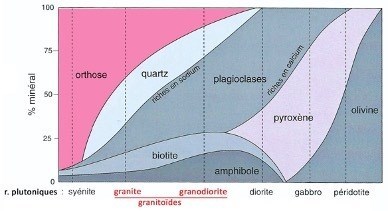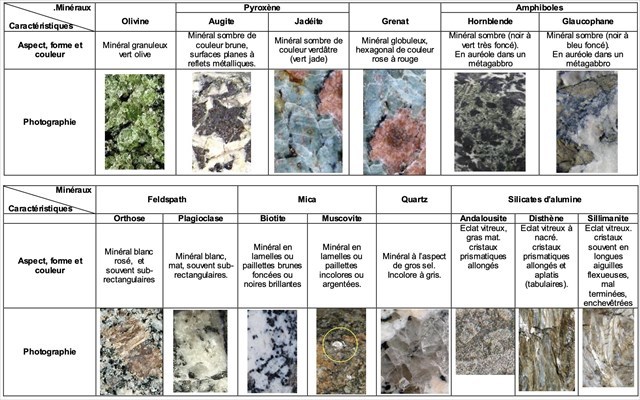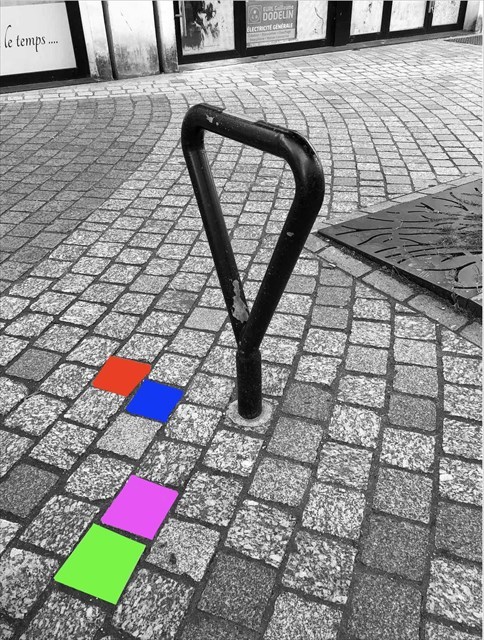

Introduction
Avec cette série de Earthcaches citadines, nous allons nous intéresser aux roches typiques de la région que l’on peut observer en se promenant dans Le Havre. Cette balade va nous permettre de découvrir des spécimens de différentes familles de roches.
La neuvième de la série est le granite (famille des roches magmatiques). On va découvrir comment comparer plusieurs roches proche du granite.
Pour plus d’information sur les roches magmatiques, vous pouvez vous référer au descriptif de l’étape 2 de cette série (§ Généralité sur les roches magmatiques).
Syénite, granite, granodiorite et Diorite
Ces roches sont toutes des roches plutoniques qui constituent la croûte continentale terrestre. Elles ont une structure grenue avec des grains angulaires (cristaux) jointifs et visibles à l’œil nu. Ces roches se sont solidifiées profondément sous terre où le processus de cristallisation était lent (d’où la taille des cristaux).
Dans le langage commun, l’ensemble de ces roches est souvent appelé granite.

Classification simplifiée des roches plutoniques
Comme le montre le schéma ci-dessus, la granodiorite est similaire au granite :
- Granite : Quartz (incolore à gris), feldspath orthoclase (minéral blanc rosé) avec ou pas de feldspath plagioclase (minéral blanc, mat). Les minéraux secondaires étant de la biotite (sombre à noire) et de l’amphibole.
- Granodiorite : Quartz (incolore à gris), feldspath plagioclase (plus abondant que le feldspath orthoclase). Les minéraux secondaires étant de la biotite, l’amphibole et la pyroxène
La syénite et la diorite sont quant à elles de structure un peu différente :
- Syénite : feldspath orthoclase, biotite, amphibole. Pas ou très peu de quartz.
- Diorite : feldspath plagioclase, amphibole. Les minéraux secondaires étant la biotite et plus rare la pyroxène.
La syénite se distingue du granite par l’absence de quartz. Il est par contre très difficile de distinguer la diorite et la granodiorite.

Les sources bibliographiques
- http://avg85.fr/wp-content/uploads/2017/11/Diaporama-Granites.pdf
- https://photos.monanneeaucollege.com/Planches_mineraux_couleurs.pdf
- https://cours.polymtl.ca/PBedard/glq1100/roches/granite/granite.html
- https://bretagne-environnement.fr/sites/default/files/3-franc.pdf https://bretagne-environnement.fr/sites/default/files/3-franc.pdf
Pour valider la Earthcache
ATTENTION, vous êtes dans les rues piétonnes du Havre. Il y a pas mal de passants dans cette rue. Vous allez surement paraître un peu bizarre à examiner le sol...
Pour pouvoir valider cette EarthCache, vous devrez répondre correctement aux questions suivantes et ajouter à votre log une photo de vous, de votre GPS ou de votre pseudo au waypoint de la cache (OPTION). Cette photo permettra de valider le « trouvé » en cas de mauvaise réponse aux questions.
Merci d’envoyer vos réponses via mon profil ou via la messagerie geocaching.com, ne les donnez pas dans votre log. Les logs enregistrés sans réponses seront supprimés.
Vous pouvez loguer la cache "trouvé" sans attendre ma confirmation, je vous contacterai en cas de problème.
Rappel concernant les Earthcaches: Il n'y a pas de conteneur à rechercher ni de logbook à renseigner. Il suffit de se rendre sur les lieux, de répondre aux questions et de me renvoyer les réponses.
Question 1 : De quelle famille de roche appartient le granite ?
Question 2 : Dans la photo ci-dessous (WP1 N49 29.486 E00 06.312), pouvez-vous me dire la couleur dominante de la roche qu’il y a sous la zone rouge ? Pouvez-vous me donner le type de roche ? Justifiez votre réponse en listant les minéraux qui la constituent.

Allez au WP2 N49 29.491 E00 06.316 pour répondre aux questions suivantes.

Question 3 : sous les carreaux rouge et bleu, pouvez-vous me donner les types de roche observées ? Sont-elles différentes ou non ? Justifier.
Question 4 : sous les carreaux rouge et vert, pouvez-vous me donner le pourcentage de minéraux sombres (10%, 30% ou 60%). Pouvez-vous me donner la taille moyenne et le nom des minéraux claires ?
Question 5 : sous le carreau rose, pouvez-vous me décrire ce que vous observez ? Taille/couleur/nature des minéraux ?

Introduction
With this series of urban Earthcaches, we are going to be interested in the typical rocks of the region that we can observe while walking in Le Havre. This walk will allow us to discover specimens of different rock families.
The ninth in the series is granite (family of magmatic rocks). We will discover how to compare several rocks close to granite.
For more information on magmatic rocks, you can refer to the description of step 2 of this series (§ General information on magmatic rocks).
Syenite, granite, granodiorite and diorite
These rocks are all plutonic rocks that make up the earth's continental crust. They have a gritty structure with angular grains (crystals) joined together and visible to the naked eye. These rocks were solidified deep underground where the crystallization process was slow (hence the size of the crystals).
In the common language, the whole of these rocks is often called granite.
The granodiorite is similar to granite:
- Granite: Quartz (colorless to gray), orthoclase feldspar (pinkish white mineral) with or without plagioclase feldspar (white, dull mineral). Secondary minerals are biotite (dark to black) and amphibole.
- Granodiorite: Quartz (colorless to gray), plagioclase feldspar (more abundant than orthoclase feldspar). The secondary minerals being biotite, amphibole and pyroxene
The syenite and the diorite are as for them of a little different structure:
- Syenite: feldspar orthoclase, biotite, amphibole. No or very little quartz.
- Diorite: feldspar plagioclase, amphibole. The secondary minerals are biotite and more rare pyroxene.
Syenite is distinguished from granite by the absence of quartz. It is on the other hand very difficult to distinguish the diorite and the granodiorite.
Bibliographic sources
- http://avg85.fr/wp-content/uploads/2017/11/Diaporama-Granites.pdf
- https://photos.monanneeaucollege.com/Planches_mineraux_couleurs.pdf
- https://cours.polymtl.ca/PBedard/glq1100/roches/granite/granite.html
- https://bretagne-environnement.fr/sites/default/files/3-franc.pdf https://bretagne-environnement.fr/sites/default/files/3-franc.pdf
To validate the Earthcache
WARNING, you are in the pedestrian streets of Le Havre. There are a lot of passers-by in this street. You will surely appear a little strange to examine the ground...
In order to validate this EarthCache, you will have to answer the following questions correctly and add to your log a photo of you, your GPS or your nickname at the waypoint of the cache (OPTION). This photo will validate the "found" in case of wrong answers to the questions.
Please send your answers via my profile or via the geocaching.com messaging system, do not give them in your log. The logs recorded without answers will be deleted.
You can log the "found" cache without waiting for my confirmation, I will contact you in case of problem.
Reminder about Earthcaches: There is no container to search or logbook to fill in. Just go to the location, answer the questions and send me back the answers.
Question 1 : Which rock family does granite belong to?
Question 2 : In the photo below (WP1 N49 29.486 E00 06.312), can you tell me the dominant color of the rock that is under the red area? Can you tell me the type of rock? Justify your answer by listing the minerals that constitute it.

Go to WP2 N49 29.491 E00 06.316 to answer the following questions.

Question 3 : under the red and blue tiles, can you give me the types of rock observed? Are they different or not? Justify.
Question 4 : under the red and green tiles, can you give me the percentage of dark minerals (10%, 30% or 60%). Can you give me the average size and name of the light minerals?
Question 5 : under the pink tile, can you describe what you observe? Size/color/nature of the minerals?